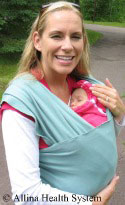
Baby carriers and car seats

Baby carriers
Slings and front packs are a convenient way to carry your baby while you shop, go for a walk or work around the house. They can also be useful in quieting a fussy baby.
There are several different styles from which to choose. It is helpful to try a style to make sure you feel comfortable wearing it.
Read and follow the instructions to make sure that your baby is secure and their head is supported.
The U.S. Consumer Product Safety Commission (CPSC) advises that parents be cautious when using infant slings for babies younger than four months old.
A baby can stop breathing and die if their face is covered, if the baby is hunched with their chin touching their chest, if the baby is too low or if the baby's face is pressed tight against the fabric of the sling.
Car seats
Choose the right car seat
There are many different car seats from which to choose. All car seats rated by the National Highway Traffic Safety Administration meet federal safety standards and performance standards.
The most important things to consider when shopping for a car seat are:
- Choose the car seat that fits your baby properly.
- Choose the car seat that fits your car correctly. Not all car seats fit well in every car or with other child restraints. Check your vehicle's owner's manual for the manufacturer's recommendations for installing child car seats.
- Choose the car seat that you will use correctly every time you use it.
Install the car seat and have it checked
Make sure the seat is properly installed according to the manufacturer's instructions and your vehicle's owner's manual. A properly installed car seat should not move more than one inch in any direction.
It is a good idea to have the installation of your car seat checked by a certified child passenger safety technician or practitioner.
It is your responsibility to know how to use your car seat. There are many resources available, including classes and car seat checkup clinics, including the following:
Tips on car seat use
- All children must be in a child safety restraint. A padded tray shield or T-shield is not recommended for newborns and small babies.
- Place the rear-facing (facing the rear window) car seat in the back seat. Riding in a rear-facing car seat is the safest position for your baby.
- According to state law, the car seat must be rear-facing until your baby is 20 pounds and one year old. Safety studies suggest that babies should be rear-facing until age two.
- Use car seats that are less than six years old.
- Never use a car seat after it has been in an accident.
- Never put your rear-facing car seat in the front seat with active airbags.
- Make sure all straps and buckles are securely and properly adjusted. The harness straps should be snug and should lie flat against your baby's shoulders.
- After your baby is buckled, position the chest clip between the nipples and collarbone as part of securing your baby into the car seat.
- Avoid bulky clothing, snowsuits, and blankets between your baby and the harness straps. You can place a blanket on your baby after the harness is buckled. If the car seat has any metal parts that may touch your baby, cover them in hot weather so they don't burn your baby
- Never leave your child alone in a car.
- Be sure to fill out and mail the car seat warranty card. The company will notify you in case of a recall or other safety notices. Check the National Highway Traffic Safety Administration's website (nhtsa.gov) for car seat recall notices.
How to keep your child in the car seat
Do not let your child get out of their car seat while in a moving vehicle. To avoid boredom on a long trip, take along games, activities, books and story tapes. Have snacks and water handy, and make lots of stops along the way. Praise your child for sitting so well in the car seat
Don't let your child give in to pressure. If they are with a friend or relative who does not use seat belts, stress how important seat belts are to your child.
And remember, all adults and all children riding in a car, truck, van, mini-van or SUV should be buckled at all times. Buckling up is a habit you want to pass on to your children.
Older child reminders
- Use an approved car seat for the height and weight of your child every time they ride in a vehicle. Your child must be in a car seat in the back seat until age four.
- Once your child has outgrown a forward-facing seat, they should ride in a belt-positioning booster seat.
- Belt-positioning booster seats are required for children younger than eight years old or shorter than 4 feet 9 inches.
- Your child needs to be in a belt-positioning booster seat until they reach the height of 4 feet 9 inches or eight years old.
- Once your child is 4 feet 9 inches or eight years old, your child can be buckled in the back seat with a lap and shoulder belt. The lap belt must lie snugly across the upper thighs, not the stomach. The shoulder belt should lie snugly across the shoulder and chest and not cross the neck or face.
- If the shoulder strap runs across your child's neck or face, a booster seat is needed.
- Never let any child put the shoulder strap under their arms.
- Keep your child in the back seat at least through age 12.